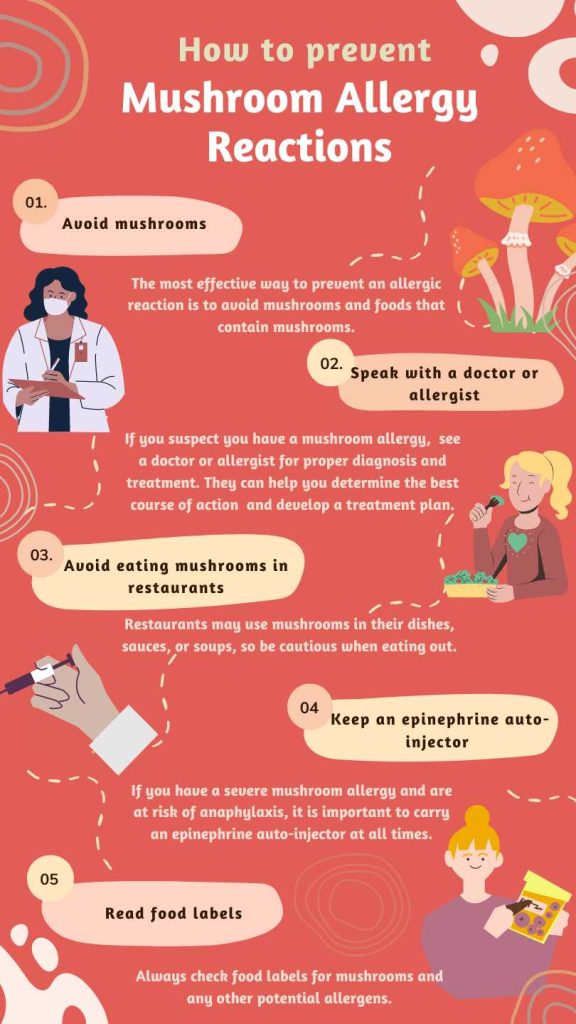Mushroom is a delicious fleshy and soft food. Many vegetarians like to consume mushrooms as a substitute for meat. But there are some situations that you may have felt discomfort after eating mushrooms. Therefore Mushroom allergy is a common topic among mushroom consumers. Before eating you should know the safety of the food you eat. right??
First of all, we should understand why it can become allergic??
You may know that Mushrooms are reproductive structures of some fungi species. There are millions of spores beneath the mushroom cap among the gills. These spores spread through the air or else you may eat mushrooms. Clearly these spores are the reasons for mushroom allergy!! [1]
What is Mushroom Allergy??

Allergy is a condition that causes some allergic reactions that will result in unfavorable symptoms in your body. Clearly, If your body is sensitive to reactions of molds ( mold sensitive bodies), this can develop as a result of eating mushrooms.[2]. And also this can occur with the inhalation of airborne basidiospores too, which have allergenic properties.
However, some researches suggest that these properties may be due to unidentified cross-reactive protein compounds. There are some situations where these allergic symptoms grow in mushroom growers. So, when the spore production is high more and more people will subject to this allergenic condition.
Particularly we can divide this condition into three sections as,
- Intolerance
- Allergy
- Poisoning
Mushroom poisoning

From all the above, especially mushroom poisoning is dangerous. Mushroom poisoning occurs as a result of eating toxic mushrooms. The most available examples are Death cap mushrooms and yellow staining mushrooms. They can be very dangerous to those who eat them Because it can be fatal to your body.
If you eat death cap mushroom you may get kidney damage or liver damage. A small amount of the mushroom is sufficient to make your body weak. It may contain poison sufficient enough to kill an average adult. There is no change in the edibility of this kind of mushrooms. If you cook, peel, Soak, or dry it no change will appear.[13]
Mushroom intolerance symptoms
But intolerance is a kind of situation which causes indigestion. Especially according to some researches this may be related to genes (OCTN1 gene). The patients with Crohn’s disease due to a gene issue have a high risk of mushroom intolerance.[14]
The primary symptoms of mushroom intolerance are abdominal discomfort and intense cramping. Additionally, there has been some research suggesting a potential link between mushroom intolerance and a worsening of symptoms in people with Crohn’s disease.
There are some situations where these allergic symptoms grow in mushroom growers. And when the spore production is high, more and more people will subject to this allergenic condition.
What are the responsible mushroom species??
You should know the species of mushrooms that cause those allergic conditions. Here are some examples,[3]
- Ganoderma( lingzhi)
- Boletus( penny bun )
- Thelephora (Fiber Vase)
- Lactarius( Milkcap )
- Russula (vomiting russula)
- Shiitake
- Oyster
These are the main types of mushrooms that affect you with allergenic conditions. Boletus are common mushrooms in Europe. These mushrooms can initiate IgE related allergy conditions. This is due to a resistant protein called as profilin. Actually this is a cross-reactive protein. According to certain studies, this is one of the reasons responsible for an anaphylactic reaction after consuming mushrooms.
When considering mushrooms like oyster and shiitake, people consume them widely and cultivate them widely. Some researchers say that individuals who work with mushrooms, especially for several years, have shown many respiratory ailments like asthma and hypersensitivity pneumonitis. In addition to these conditions, they also can be subjected to toxicodermia as well.[15]
It will be an easy process if there are many diagnostic tests for identifying a mushroom allergy. But Unluckily there are very few available diagnostic tests to screen the allergic condition. Therefore it is difficult to identify potential lung diseases associated with these mushrooms.
How allergic reactions occur in your body??
Of Course, allergy starts If you are a mold sensitive person and you exposed to mushroom spores. Usually, allergic reactions occur due to unidentified cross-reactive proteins as we discussed above. Therefore following reactions may occur in the body

- The body starts to produce allergic antibodies ( we call them Immunoglobulins)
- Antibodies find these cross-reactive proteins and direct them to Mast cells (White blood cells)
- They will destroy these protein molecules
- As a result, histamine releases into the blood
- When the concentration of histamine increases different symptoms starts to appear in the body [8].
Now let’s take a look at what are the symptoms of this allergy. You should know that the symptoms can be different based on the sensitivity of the body.
What are the Symptoms of mushroom allergy??
Clearly we mentioned in the above chapters that inhalation of spores can cause different disease conditions. You may get the following conditions,[4]
- Asthma
- Rhinitis
- Coughing
- and dyspnea
Clearly Rhinitis is an inflammation condition of mucous membranes ( it is a lining of the respiratory tract). Due to that, you may feel sneezing, stuffiness in the nose, or runniness nose. You will feel an overall discomfort situation in your nose.
When considering asthma, it is important to know that your body is more sensitive to molds. Otherwise, if you have asthma, exposure to these mushrooms will lead to severe asthma attacks!!
What about Dyspnea?? Well, it is a discomfort feeling related to breathing. Breathing becomes difficult in dyspnea. However, some refer to this as shortness in breathing[5]. Coughing also becomes severe in this allergic condition.
What are the mushroom allergy symptoms due to eating??
You should know that, Unlike due to inhalation, due to consumption, allergic relations are somewhat low. There is a limited number of cases on this. But if you are consuming mushrooms frequently there is a huge possibility of you subjecting to mushroom allergy. So you must know the below facts.
First, let’s see what are the most common mushroom species causing this allergy. Well, there are a few species that belonging to this allergenic category. But they are popular in Asian countries including Korea, China, Japan, etc.[6]. These species are,
- Shiitake (Lentinula edodes)
- Maitake (Grifola frondosa)
- Shimeji (Lyophyllum decastes)
- Matsutake (Tricoloma matsutake
Symptoms
Some researchers suggest that the above mushroom types have a higher tendency for allergies. Shiitake is harmful in terms of inhalation and ingestion both. Now let’s see what are the symptoms associated?? [6],[7]
- Edema
- Urticaria
- Skin rashes and irritations
- Vomiting
- Diarrheal conditions
- Bloating of stomach etc
How do you diagnose mushroom allergy for sure??
Especially after eating mushrooms or handling mushrooms Look for symptoms. You should identify whether there are the above-mentioned symptoms in your body. If the symptoms are positive then you should go under medical supervision to make sure that you have a mushroom allergy.
Under the medical tests, you will undergo skin prick tests, Anterior rhinomanometry test, and provocation tests.[4]
In this Anterior rhinomanometry test, your airflow is recorded. Usually, in here one of your nostrils is covered and airflow is measured with suing a reference pressure. If there is a 40% reduction in your airflow, that means your allergy is positive [8]
Particularly skin prick test is done on your forearm. After doing the test they check for the test results after about 20 minutes.[9] If the diameter of the skin patch is greater than 3 mm, it’s possible that you have the allergy.
In terms of provocation tests, clearly doctors do them to determine the sensitivity of your lungs. More specifically they are to detect the prevalence of asthma. In terms of mushroom allergy surely it takes about two and a half days for the test. One day for control day, another day for exposure, and a half-day for observations. If there are the following results, there is more possibility that you have allergic reactions.
- Increase in your count of leucocytes
- Temperature rise
- Reduction of your total lung capacity
How do you prevent mushroom allergy??
If you want to prevent mushroom allergy, then you should control the factors causing the allergy. So, these are the thing that you can do to protect you from mushroom allergy.
- First things first, protect yourself from exposure to mushrooms. And also prevent the frequent consumption of mushrooms if you have a body that has an allergic sensitive body.
- Try as much as possible to avoid exposing to different molds
- keep some antihistamine drugs such as brompheniramine, cetirizine, and hydroxyzine, etc. to use in case of an allergy.
- Furthermore, avoid cooking or handling mushrooms that are not familiar to you, Especially wild mushrooms.
- And also you must be cautious in eating packed foods like dried fruits and alcoholic beverages like wine and beer. Because they may induce allergic reactions. In addition products like pickle meat also creates the same reactions we discussed above. So be smart in choosing your food!!

How long does mushroom allergy last?
The duration of mushroom allergy depends on individual factors. In some cases, the symptoms may last only a few minutes to an hour in one person, while in others they may persist for several hours or even days.
The duration and severity also depend on the amount of mushrooms consumed and the individual’s specific allergy. Some people may experience a severe reaction even after consuming a small amount, while some may show mild reaction after consuming a small amount of mushrooms.
Remember to visit a doctor or an allergist for proper diagnosis and treatment, If you suspect you have a mushroom allergy. They can help you determine the severity of your allergy and develop a treatment plan to help manage your symptoms.
What are The mushroom allergy treatments?
However, the first thing before treatment is prevention as mentioned above. For that, it is important that you prevent from exposure to mushrooms if you have allergy sensitive bodies.
- It is very important that you intake the recommended anti-histaminic drugs such as brompheniramine, cetirizine, Chlorpheniramine, and clemastine, etc. Usually, you can use them in allergic conditions. And you can take them in oral form or as a nasal spray.[7]
- Steroid sprays for inhalation are a good example of nasal sprays.
- Particularly in certain studies, in lung difficulty, some patients have given prednisone and salmeterol for two months. Clearly, until the treatment period, the patient should avoid any form of mushrooms
- In case of severe conditions, if you have serious symptoms, you will be given epinephrine or adrenaline injections.
In the bottom line, it’s important to say that always be cautious with the food you eat. Try as much as possible to cook your food properly. And try to avoid mushroom growing areas especially if you have asthma conditions.
Frequently Asked Questions
Mushroom allergy rash images


Mushroom allergy foods to avoid
As we dicussed above, in any case if your body shows allergic reactions to foods containing mushrooms or foods derived from mushrooms you must avoid them. Given below are most common food types that may contain mushrooms and possibly cause allergic reactions.[16]
- First you should restrict your diet from fresh or dried mushrooms, including common varieties like Shiitake, button, black truffle ,morels and portobello mushrooms.
- Avoid some soups or broths which contain mushrooms as an ingredient, such as cream of mushroom soup or Mushroom miso soup.
- Complementary foods such as mushroom sauces and gravies that contain mushrooms are also needed to be avoided.
- Sometimes vegetarian or vegan meat substitutes also may contain mushrooms, such as mushroom burgers which you need to avoid.
- In addition to mushroom itself sometimes cheeses such as Roquefort, may be made using mold that can trigger mushroom allergy in your body.
- Ba cautious when taking supplements because there are some supplements and medications which may contain mushroom-derived ingredients.
Mushroom allergy rash
Most of the researches on mushroom allergy skin rashes are associate with shiitake mushrooms. These mushroom-induced flagellate dermatitis usually occurs within a range of 12 hours to 5 days after ingestion. However, the symptoms usually occur within 24 hours. As the name suggests this is characterized by itching, red colored linear streaks that resemble whiplash marks. Most patients recover completely within 3 weeks, with or without treatment.
However the actual cause of this condition is not clear, but the leading theory suggests that this is a toxic reaction to lentinan, a polysaccharide found in shiitake mushrooms.[17][18]
Shiitake mushroom allergy
This allergy is characterized with a skin allergic condition which we call as Shiitake Dermatitis. This condition is triggered by a toxic reaction to lentinan, which is a thermolabile polysaccharide that breaks down when heated.[18]
Shiitake mushroom allergy symptoms are associated with a skin rash that looks similar to marks left by a whip and develops after eating raw shiitake mushrooms.
Mushroom allergy home remedy
There are some home remedies associated with mushroom which you could use to get some relief from allergic reactions until you seek the proper medical attention. But remember those remedies may not be guaranteed as medical treatments of a professional medical officer.
- Antihistamines can help relieve symptoms such as itching, hives, and congestion. They are available over-the-counter and can be taken as needed, but be sure to follow the recommended dosage and check with your doctor first.
- Research studies suggest that you could use apple cider vinegar as a natural remedy for allergies. Mix one tablespoon of apple cider vinegar in a glass of water and drink it daily. Some people claim that this can help reduce allergy symptoms.
- Honey is a natural anti-inflammatory and may help reduce allergy symptoms. Try taking a spoonful of local, raw honey every day to see if it helps alleviate your symptoms.
- Several study reports, based on their results indicate that probiotics may have the ability to influence the immune system and limit allergic responses.
It’s important to note that while these home remedies may be helpful for some people, they are not a substitute for medical treatment. If you have a severe or life-threatening allergy to mushrooms, seek medical attention immediately.
Mushroom allergy in babies?
Mushroom allergy in babies is a rare occurence. Although there can be many foods that may cause allergic reactions in babies ,mushrooms are not a potential threat to your baby. However, there can be mushroom poisoning situations if you are not very careful abut your child.
In any case of mushroom poisoning, feeling sick, stomach cramps, vomiting, and watery or bloody diarrhea are early symptoms. If your child exhibits any of these symptoms, it’s important to contact your healthcare provider immediately or visit the nearest emergency department. It’s worth noting that all toxic mushrooms can cause vomiting and stomach pain.
Tiger milk mushroom allergy
There are no sufficient data or research studies conducted about allergic reactions in tiger milk mushroom allergy. But some research studies suggest that it is an effective supplementation for immune health and respiratory health.
Oyster mushroom allergy symptoms
Unlike the other edible mushroom varieties, Oyster mushrooms have a shorter growth period which increase it’s productivity. The allergic reaction associated with these mushrooms are quite low. There are rare cases of reported oyster mushroom allergy in certain individuals showing symptoms like fever, chills, joint pain and skin rashes with hypersensitivity pneumonitis.
You may also like,





